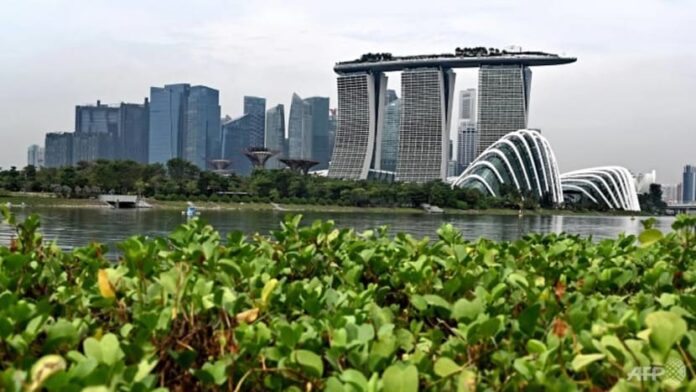SINGAPORE: Changes to Singapore’s carbon tax should be carefully calibrated and adjusted to give businesses enough time to adapt and remain competitive, Trade and Industry Minister Gan Kim Yong told parliament on Wednesday (Jan 12).
He noted that setting the right carbon price would guide investment decisions and spur companies to decarbonize, but would also impose higher costs on businesses and consumers.
“We should carefully calibrate and adjust the rhythm to give businesses enough time to adapt, implement decarbonisation measures and remain competitive,” Mr Gan said.
Citing the S$180 million corporate sustainability plan launched in October last year, he said the carbon tax would be supplemented by financial support for businesses.
The minister said the government would also consider how it could help mitigate rising costs, especially for low-income households, as the higher carbon tax would have an “indirect impact” on households.
For example, when the carbon tax was first introduced in 2019, the government offered an additional U-Save utility tax rebate for three years, he noted. A program that provides vouchers to eligible households to offset the cost of energy-efficient appliances has also followed.
Mr Gan is responding to a motion on climate change put forward by PAP MPs, calling on the government to strengthen green financing, create more green jobs and more.
In a wide-ranging debate that lasted more than five hours, the focus was on raising the carbon tax, seen as a key tool in Singapore’s transition to a greener future.
The country’s existing carbon tax will last until 2023 and is currently fixed at S$5 per tonne of emissions. Finance Minister Huang Xuncai said the revised carbon tax rate for 2024 would be announced in this year’s Budget.
Raise the carbon tax rate
MPs who spoke at the debate, such as Mr Louis Ng (PAP-Nee Soon), agreed that the current carbon tax was too low.
Mr Wu said the tax rate was the “most powerful tool” to cut emissions and had to be raised “substantially”. It could also be expanded in scope, he said.
Currently, Singapore’s carbon tax applies to all facilities that generate 25,000 tonnes or more of greenhouse gas emissions per year. This covers about 50 large emitters and accounts for 80% of Singapore’s total carbon emissions.
“We should aim for higher coverage,” Wu said, adding that small emitters with emissions of at least 2,000 tonnes were already considered “reportable facilities” and were paying to monitor and measure their emissions. cost.
“Given that any additional compliance costs are likely to be small, it makes sense for the carbon tax to cover all reportable facilities,” he added. “A launcher, big or small, can do its job.”
Mr Saktiandi Supaat (PAP-Bishan-Toa Payoh) also suggested the establishment of a fixed carbon tax rate formula to develop over a longer period, which would help businesses predict their potential costs and plan accordingly.
While some experts have suggested a carbon price of $50 to $75 per tonne of carbon dioxide by 2030, he stressed that the pace of the increase must be determined carefully.
He suggested first setting the carbon tax level at at least $8 to $9 per ton of emissions, “or just a little bit higher, to inject some urgency for emitters to accelerate their decarbonization plans”. This price floor is where the voluntary market assesses and trades carbon credits, he said.
Supporting businesses in transition
MP Liang Eng Hwa (PAP-Bukit Panjang) pointed out that businesses will face transition costs such as higher capital expenditure and compliance costs against the backdrop of supply chain disruptions and slowing global growth.
Therefore, helping businesses “overcome the initial tough challenges” in this transition is critical, he said. For example, tax increases should be rolled out gradually with a clear timetable.
It should also receive government support, he said, citing measures such as increased financial support to help the industry become more energy efficient.
Additionally, MPs Foo Mee Har (PAP-West Coast) and Mariam Jaafar (PAP-Sembawang) said businesses should be given ample time to adjust.
Ms Foo cited Sweden as an example, which she said went through a 30-year phased implementation before reaching the current carbon price “without affecting the economy”.
“A clear long-term trajectory for expected changes in carbon taxes will be key to helping companies develop the business case for adopting new green technologies and making the necessary investments,” she added.
Mr Ng and Ms Foo also suggested that the additional tax revenue from increasing the carbon tax be given back to those affected, either as a subsidy to deal with higher costs during the transition, or as an incentive for companies to adopt green technologies.
Balancing coverage with potential compliance costs
Describing the carbon tax as the “core” of Singapore’s climate mitigation strategy, Sustainability and Environment Minister Grace Fu also agreed that “stronger price signals” are needed over time for companies to take bolder decarbonisation step.
But she reiterated the need to balance tax coverage with potential administrative costs for businesses.
She said the existing carbon tax thresholds ensured that the tax was applied at “critical junctures” and flowed to the rest of the economy. “This eases the administrative burden on small emitters, especially (small and medium enterprises) to measure, report and verify their emissions.”
But she agrees that it is necessary to use carbon tax revenue to support the company’s decarbonization journey.
“In fact, in the first five years, we are prepared to spend more money than we have collected to encourage the adoption of energy-efficient processes and other valuable emission reduction projects,” she said, adding that some of the revenue will also be used to help households .
Ms Fu added that additional funding was also being used for research and development of low-carbon technologies and urban solutions.






